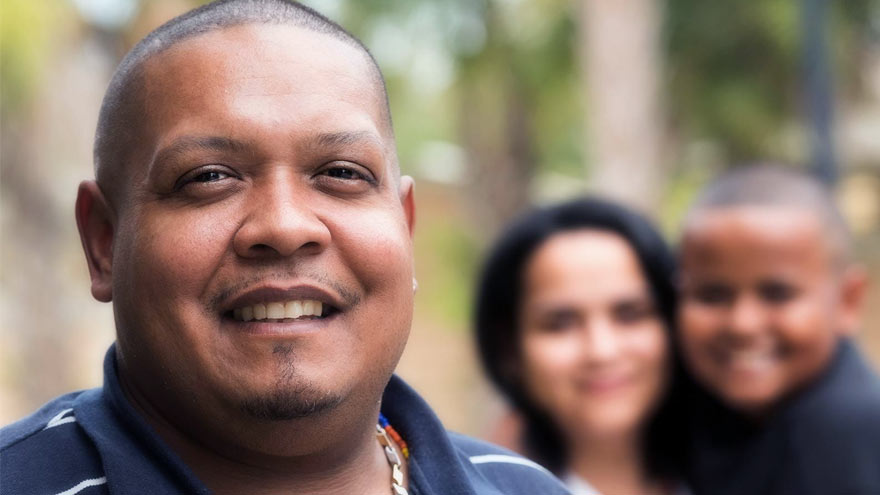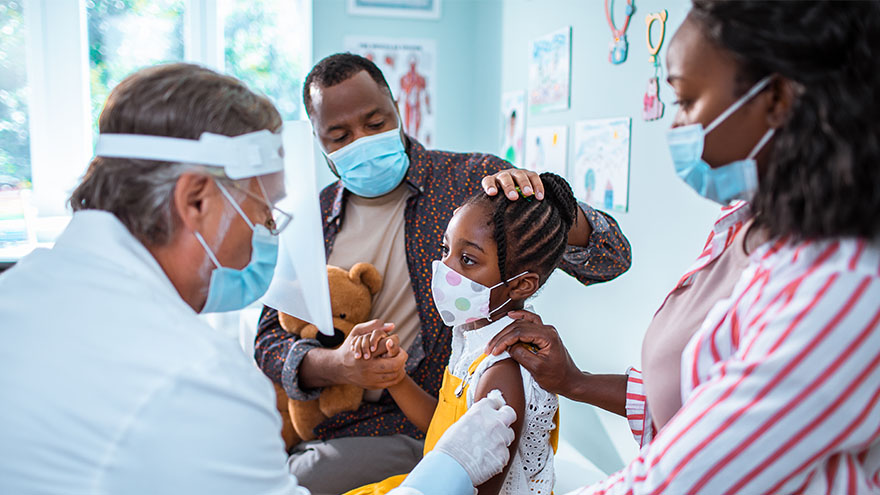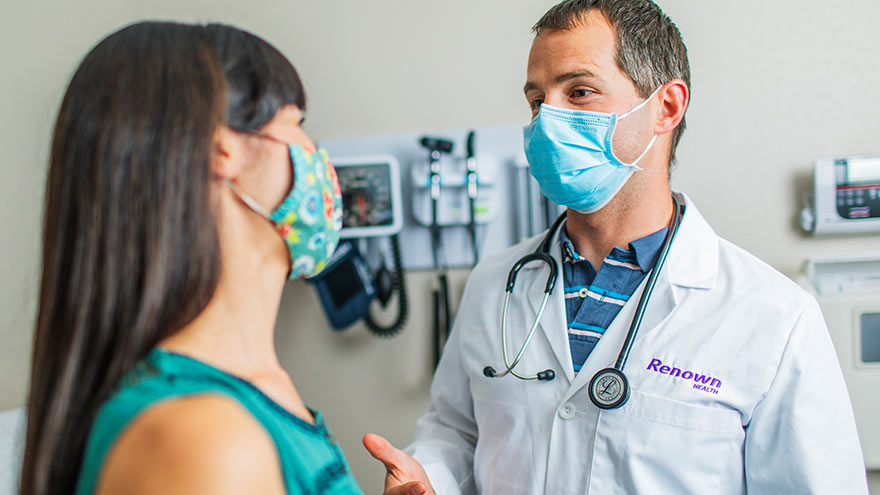Search
-
Here's How to Commemorate National Healthcare Decision Day
National Healthcare Decision Day is forthcoming. Here’s an easy and free way to commemorate the occasion: openly discussing how we want to be cared for at the end of our lives. Join Renown Health’s experts at a workshop about making decisions about an advance directive. Among the random national holidays, this one has significance: April 16 is National Healthcare Decision Day. And experts agree that the best time to discuss your views about end-of-life care and to learn what choices are available is before a life-limiting illness or crisis occurs. By preparing in advance, you can help reduce the doubt and anxiety related to decision making for your family if you cannot speak for yourself. “Completing your advance directive is a gift you give your family,” says Mary-Ann Brown, RN, MSN, director of Palliative Care. “The stress associated with these difficult decisions is decreased if everyone knows what is important to you and what you want the end of life.” What Are Advance Directives? An advance directive is a document that states your choices about medical treatment and names another person to make medical decisions on your behalf if you are unable to. This document allows you to make legally valid decisions about future medical care. Find more information about advance directives and the form online. The Conversation The first step in completing an Advance Directive is to think about what’s important to you and talk to your loved ones. The Conversation Project provides helpful tools to guide you and your family through this challenging topic. Getting this information together will help you fill out and complete your advance directives. Some things to consider and discuss with your family include: When you think about the last phase of your life, what’s most important to you? Who do you want involved in your care? Who should make decisions on your behalf if you’re not able to? Where do you want or not want to receive care? Are there specific treatments you would or would not want? Complete Your Advance Directive Planning In order to complete an advance directive, you will need either two witnesses or a notary to sign the form. Be sure to note restrictions on the witness process. When an advance directive is complete, you should keep the original. Copies should be given to your agent named in the form, your family, your doctor(s) and the location that you receive care. Renown Health offers four advance directive workshops every month to cover the details of filling out this document. A healthcare team is available to answer questions and work through the process with you. A notary is also present to finalize the process, which means you can complete your advanced directives during this workshop. Find the workshop by calling 775-982-RSVP for more information. Advance Care Planning Workshop April 17, 1-2:30 p.m. | Free Join Renown Health’s experts for a workshop about making decisions regarding end-of-life care. You will learn how to fill out an advance directive, receive one-on-one assistance and have your documents signed by a notary. Workshops are typically held several times each month. To RSVP, call 775-982-7787
Read More About Here's How to Commemorate National Healthcare Decision Day
-
Ask the Expert: What is Scoliosis?
Posture is important, but for those children diagnosed with scoliosis (spinal curvature) it can be a difficult issue. The Washoe County School District Student Health Services Department screens 7th grade students for scoliosis as growth spurts often reveal the condition and, if diagnosed early, scoliosis can stop progressing. We asked Michael Elliott, MD, head of the Department of Pediatric Orthopedics and Scoliosis to answer some frequently asked questions about scoliosis. What is scoliosis? There are many types of scoliosis: early onset (occurs before age 10), congenital scoliosis is when the bones of the spine do not form correctly, neuromuscular scoliosis which is due to children’s neurologic and muscle disease, and the most common is Adolescent Idiopathic Scoliosis. The term “idiopathic “ means the exact cause is unknown, although we do know it runs in families. This type of scoliosis occurs in 2-3 percent of adolescents and is mainly seen during their growth spurt. This is why middle school screenings are recommended. Both genders get scoliosis but girls are 8 times more likely to have their curves progress and become larger. What are the signs that my child may have scoliosis? A few signs for parents to watch for are: One shoulder might be higher than the other. One leg may seem longer. A hip may be higher or look more prominent. The waist may not look the same from side to side (asymmetry). The trunk or rib cage may be more prominent on one side or shifted. When they bend forward they may have a bump on their back. How is scoliosis diagnosed? It can be noticed by a pediatrician at a physical, school screening nurse, PE teacher or parents. Once the curve is suspected the child is usually referred to a pediatric orthopedic surgeon scoliosis expertise. At the initial visit the doctor will perform a thorough physical including a complete neurologic exam to assess the amount of curvature. Once the exam is completed the physician will determine if a spinal x-ray is needed. The curve on the x-ray is measured utilizing the cobb angle (a measurement in degrees) which helps guide the treatment. What are common treatments for scoliosis? The treatment depends on the size of the spinal curve and the amount of growth the child has remaining. An x-ray of the child’s hand is used to determine the amount of growth remaining. This allows the determination of the child’s bone age, and based on the hands growth plates it can determined if the child is in their rapid phase of growth. Treatments include: Observation - For curves less than 20-25 degrees. This entails visits every 6-9 months with a repeat scoliosis x-ray. Since scoliosis curves increase only 1-2 degrees per month, and variations in measurements can be 3-5 degrees, an x-ray is not recommended before 6 months. If the curve remains less than 25 degrees the child is followed until their growth is completed (usually age 16-18). Progressing Curve - If growth is finished and the curve is less than 40 degrees, the risk of more curvature into adulthood is small. If growth is completed and the curve is over 45 degrees, the child is followed for several years as these curves can progress into adulthood. If the patient is still growing and the curve has progressed greater than 25 degrees but still in the non-operative range (less than 45-50 degrees) bracing is used to stop the progression of the curve. Bracing - Indicated for curves over 25 degrees but less than 45 degrees. If a brace is required you will be referred to an orthotist (bracing specialist). The orthotist assesses your child, reviews the x-ray and then fits the brace. (Having a brace made usually takes 2-3 weeks.) Once the brace is fit, your child will visit the scoliosis specialist for an x-ray in the brace to ensure it fits correctly. The primary goal of bracing is to halt progression of the curve and prevent the need for surgery. The brace must be worn for about 16 hours per day to be effective. In a recent bracing study 72% of the patients who wore their braces as prescribed prevented the need for surgery compared to the group who did not wear their brace. Surgery: When a curve reaches 45-50 degrees, and a child is still growing, surgery is usually recommended because the curve is likely to continue progress. If a curve is over 50 degrees and the child is done growing surgery also may be recommended. This is because when curves are over 50 degrees they tend to increase 1-2 degrees per year for the rest of your life. As curves get larger the amount of lung function tends to decrease which could cause breathing problems later in life. The goals of surgery are to stop the progression of the curve and safely correct any misalignment. This is accomplished by attaching implants (rods, screws, hooks and bands) to the spine. Bone graft is then placed around the implants to encourage the spine to fuse (grow together). This then forms a solid column of bone with metal rods in place, preventing the curve from changing. Most patients are back to their regular sports and activities six months post surgery.
-
Is Bariatric Surgery Right for You?
You’ve likely heard about bariatric surgery — and perhaps even have friends who’ve done it. But is it a potential solution for you? Here, Dawn Remme, RN, Metabolic Bariatric Surgery Program Manager, provides insight. You may have been struggling with excess weight for years. You’ve tried high-protein diets, low-carb diets and more. Most patients considering weight loss surgery have tried numerous dieting methods. The truth is, some patients who suffer with obesity are successful dieters. Unfortunately though, excess weigh often returns. This impacts their health and the quality of their life. It can be a disheartening battle. Weight loss surgery is a big decision. In making this decision, keep in mind that surgery is only one step toward your goal of achieving better health. It is neither magic, nor is it the “easy way out.” Weight loss surgery can offer you a TOOL to help you become more successful in controlling the disease of morbid obesity. By combining this tool with a lifelong commitment to important lifestyle changes, medical follow-up and nutritional modifications, you have the potential to become a healthier you. Bariatric Surgery By the Numbers Exploring the facts about obesity, how it impacts your health, and how surgery can resolve or significantly improve your chronic medical conditions is the first step to making a decision. Obesity is medically defined as “excess body fat” and is measured by a mathematical ratio known as the Body Mass Index (BMI). To calculate your BMI, we consider your height, weight, age, gender and body build. Here are the standards: “Normal” BMI: less than 25 Overweight: 25 – 29.9 Obese: BMI of 30 – 39.9 Morbid obesity: BMI of 40 or more Morbid obesity (BMI over 40) is a lifelong, progressive disease, and the prevalence of morbidly obese Americans (100 or more pounds over a healthy weight) is increasing rapidly. According to the CDC, the disease of obesity affects 78 million Americans. Further estimates indicate about 24 million have morbid obesity. Serious medical problems known as co-morbidities often occur when someone is morbidly obese. Studies tell us conditions such as type 2 diabetes, high cholesterol, sleep apnea, high blood pressure and degenerative arthritis increase in severity as the BMI is increasing in patients. When may weight loss surgery be an option? When someone has a BMI greater then 40. If a person’s BMI is 35 – 39.9 and they have significant health problems such as type 2 diabetes, high blood pressure, high cholesterol, sleep apnea, or other diagnosed health conditions related to obesity. Gastric Sleeve, Gastric Bypass Explained To resolve or significantly reduce these health conditions, bariatric surgery can be done when diet and exercise haven’t worked. Weight loss surgery makes changes to your digestive system to help you lose weight. The gastric sleeve limits how much you can eat, whereas gastric bypass limits how much you can eat and reduces the absorption of certain nutrients. Other Benefits of Surgery You can greatly increase life expectancy by resolving or significantly improving conditions like diabetes, high cholesterol, high blood pressure, sleep apnea, and obesity itself. Infertility can also be positively affected. A significant weight loss and relief from serious health conditions and diseases will greatly improve your quality of life. Studies tell us that type 2 diabetes is resolved or significantly improved in 84 percent of patients following bariatric surgery. Cholesterol levels dropped in 95 percent of patients. And hypertension and sleep apnea showed improvement in 68 and 80 percent of patients, respectively, following bariatric surgery. Bariatric Surgery at Renown In making the decision to move forward to better health, it is important to remember: Obesity is a disease, and the desire to have a healthier, longer, more fulfilling life is possible. If you are interested in learning more, please visit the Bariatric Surgery Program page to view more information about Renown Regional Medical Center’s MBSAQIP accredited bariatric program, as well as information about upcoming educational seminars. Or call 775-982-RSVP (7787) to reserve your seat. Learn More
-
Make a Healthier Grilled Cheese Sandwich
Friday, April 12 is National Grilled Cheese Sandwich Day! So Let us help you create a healthier melt-in-your-mouth version to this popular cheesy sandwich. Ah, the grilled cheese. It’s the quintessential comfort food that not only pairs easily with a cup of soup, but it’s easy to whip together with just a few ingredients. There are many reasons to celebrate the gooey cheesiness of this toasted sandwich, but at nearly 700 calories, it’s definitely an occasional treat. But with just a few ingredient swaps — think light mayonnaise or toasting the bread in a toaster instead of slathering it in butter — you can remake your grilled cheese into a mouth-watering and nutritious meal. We’ve compiled a couple of easy substitutions, and some of our favorite healthy twists, so you can try a new variation of an old favorite. Be Choosy with Your Cheese It’s the star of your sandwich, but do you need to always grab the yellow slices? Try to opt for stronger flavors, like blue cheese or extra-sharp cheddar, to help you retain flavor while using less cheese on your sandwich. Better Bread Goes A Long Way Plain old white bread might be your toast of choice, but by choosing a whole wheat or multi-grain bread for your sandwich you’re not only adding in new crunch and flavor, you can also increase your fiber and nutrient intake. Hold the Butter Your mom, and maybe even your grandmother, probably spread a layer of butter on your grilled cheese throughout your childhood. But know this: It isn’t necessary. While butter helps crisp the crust, it doesn’t add too much in the way of flavor. Instead, brush the bread with olive oil, or try using a thin layer of reduced-fat mayonnaise or a creamy spread. Or skip grilling altogether by toasting your bread and then baking your sandwich open faced in the oven for a few minutes at 350 degrees. Healthier Options Looking for a new twist? Here are three incredibly tasty (and healthier) versions of the traditional grilled cheese sammy. 1. Baby Swiss And Tomato Grilled Cheese 2. Green Grilled Cheese 3. Spinach, Pesto & Havarti Grilled Cheese
-
Dietitans' Top Advice to Avoid Holiday Weight Gain
The weight gain struggle is real with tempting holiday celebrations and treats. It’s hard to focus on nutrition with social events, shopping and a hectic schedule. And no one wants to diet during the holidays. Renown Health Registered Dietitians Kim Colegrove and Bristy Zimmerman, share their tips below for enjoying the holiday season without packing on extra pounds. Your holiday nutrition strategy doesn’t have to be all or nothing. Instead, Colegrove and Zimmerman emphasize realistic approaches to keep weight gain in check during the holidays. Plan Ahead to Avoid Weight Gain “Thinking ahead is key for staying on track with your weight and health goals,” says Colegrove. “Arranging to have a healthy snack ahead of time is a good idea to avoid overeating at parties. You could also bring a healthy dish to the party, then you know there’s at least one option that will fit into your meal plan. Or you might also think about eating some of your favorite party foods, but then consider the rest of your week and balance it out accordingly. All foods can fit! It’s all about balance and portion control.” Keep Moving Your Body Colegrove also urges us to stay active. “There are so many benefits of exercise! Besides aiding in weight management, physical activity can boost our mood and help us to cope with stress. For many, the holidays can be a very busy and stressful time, which may contribute to overeating and weight gain. So keep up the routine! Exercise is a vital tool in maintaining weight and managing stress, especially during the holiday season.” Slow Down and Be Satisfied “Slowing down at any meal, including the holidays, can help us pay attention to our satiety or fullness cues,” encourages Zimmerman. “Try putting your fork down between each bite of food, focus on chewing eat bite thoroughly and stop eating when you feel satisfied rather than eating to the point of discomfort.” Divide Your Plate to Conquer Weight Gain Traditional holiday foods tend to be high in calories from added fat and sugar, so it’s extra important to be mindful of our portions. Zimmerman suggests an easy visual cue. “First, try filling half of a 9-inch plate with lower-calorie foods like non-starchy veggies or salad. Secondly, fill a quarter of your plate with a meat or protein-rich food. Then save the remaining quarter of your plate (about the size of your fist) for the higher-calorie carbohydrate foods like mashed potatoes, stuffing, or cornbread. If you want to enjoy several of these foods, just make the portions small enough to still fit in that quarter of your plate.” Liquid Calories Count “Still or sparkling water will always be the best beverage choice when avoiding weight gain,” advises Zimmerman. “If you really enjoy holiday beverages, try modifying your favorite recipes by using low-fat milk or alternative sweeteners. Be mindful that calories from sweetened beverages and alcohol can add up fast. For example, if you usually enjoy several drinks at a holiday party, even reducing from three drinks to one drink can save significant calories.” You can set yourself up for success in the new year by having an eating game plan. “It’s important to be realistic about the holidays. They only come once a year, and they should be enjoyed! But plan ahead and find a good balance,” urges Colegrove. “Going into the holidays, it’s important to anticipate temptations and be prepared at social events. Don’t let the holiday season derail your efforts and enjoy in moderation!”
Read More About Dietitans' Top Advice to Avoid Holiday Weight Gain
-
How to Ease Your Child's Fear of Vaccines
Getting a shot can be scary for kids and anxiety-inducing for parents and caregivers. With flu shot season well underway and children's COVID-19 vaccine clinics in full swing, we wanted to share ways to reduce the stress for you and your child. Plan Ahead and Be Honest A few days before the scheduled appointment, casually mention to your child that you’re both going to the doctor’s office (or vaccine clinic, or pharmacy) soon for their vaccine. Explain to them that this will help protect them and will only take a second. Being honest is important, telling your child that it will hurt for a moment. If possible, try and schedule the vaccine at a kid-specific vaccine clinic, your pediatrician's office or a school-based site. Remember that words are powerful. Take notice if you are using a word that might make them more upset, such as prick, jab, needle or shot. You can interchange words such as vaccine, immunization or injection. Bring Toys Don’t be afraid to let your child bring one of their favorite toys or stuffed animals to the appointment. This can make them feel more comfortable and provide distraction. Ask for Pain Reliever/Numbing Agent If you know from past experience (or suspect) that your child has a needle phobia, talk to the vaccination location ahead of time and ask if they can use a pain reliever or numbing agent before administering the vaccine. Distract. Distract. Distract. Sing a song, tell them a joke, make a funny face. If you can pull your child’s attention away from the needle and make them laugh, they won’t focus all their energy on worrying about the shot. Lead By Example If you haven't gotten your flu shot, COVID shot or COVID-19 booster yet, ask the facility ahead of time if you can also get a shot before your child. Show them that the shot is no big deal and that they will have no problem getting it themselves. Celebrate Don’t be afraid to celebrate this victory with your child once it is over – bring them to the park, go out for an ice cream cone, let them pick what’s for dinner. This reward will show that you’re proud of them for being brave and may also make the next time your child is due for a shot easier.
-
Making a New Year's Resolution: It's Not Just for Grownups
The New Year is just around the corner, and many of us are making resolutions to better ourselves and improve our lives. But who says it's just for grownups? This January have some fun, and set a New Year's resolution with your child. Your children are bound to love ringing in the New Year with their very own resolutions. And there are lots of benefits to your child coming up with their own resolutions: Self-discipline, self-improvement, commitment and the value of making goals and following through. 1. Get the family involved Sit down together and reflect on the past year and discuss accomplishments and goals. 2. Make them specific Just resolving to “do better in school” probably won’t work. Set a specific goal. 3. Write them down Have each family member write down their resolution and post the list somewhere where it can be seen often. 4. Be a role model Come up with a resolution of your own. If your child sees you stick to your resolution; odds are they will too. 5. Pick a reward Having something fun to work towards can always be a good incentive. Just be sure you both agree on the reward ahead of time.
Read More About Making a New Year's Resolution: It's Not Just for Grownups
-
COVID-19 Booster Shots, What You Need to Know
Getting the COVID-19 booster is the best way to protect yourself from severe illness or death due to COVID-19, and both the CDC and the FDA have approved booster shots for people ages 18 and older. So, with the holidays right around the corner and infection rates on the rise both in Nevada and nationally, the best thing you can do to prevent the continued spread of this deadly virus is to get boosted today. The Basics: Who: It is recommended that everyone 18 years or older get a COVID-19 booster shot. When: At least 6 months after completing your primary COVID-19 vaccination series. What: Any of the COVID-19 vaccines authorized in the United States. The CDC allows for mix and match dosing for booster shots. How: To make an appointment for your COVID-19 vaccine booster, please visit vaccines.gov today. Appointment Reminders: Don’t forget to bring your CDC vaccination record card to your appointment. Refresh yourself on the potential side effects and remember that these are normal signs your body is building up protection. Commonly Asked Questions: Q: Does anything change if I received the Johnson & Johnson as my first COVID-19 vaccine? A: If you received the Johnson & Johnson COVID-19 vaccine, you are elidable for a booster two months after completing your primary vaccine. Q: Is the formula the same for the boosters as it was for the primary vaccine? A: COVID-19 booster shots are the same formulation as the current COVID-19 vaccines. However, in the case of the Moderna COVID-19 vaccine booster shot, it is half the dose of the vaccine people get for their primary series. Q: Am I still considered “fully vaccinated” if I don’t receive a COVID-19 booster shot. A: Yes, everyone is still considered fully vaccinated two weeks after their second dose in a two-shot series, such as the Pfizer-BioNTech or Moderna vaccines, or two weeks after a single-dose vaccine, such as the J&J/Janssen vaccine. All information courtesy of the Center for Disease Control and Prevention. All information courtesy of the Center for Disease Control and Prevention
Read More About COVID-19 Booster Shots, What You Need to Know
-
3 Ways to Switch to a Medicaid Plan Accepted at Renown
Medicaid plays a significant role in our health care system and is the nation’s public health insurance program. In addition, this program is the predominant source of long-term care coverage for Americans. Renown Health is contracted with two Medicaid plans: Molina and Anthem. If you currently have a different plan but want to change to one that Renown accepts, you can request to change plans during the open enrollment period from January 1 to March 31. Request to change your Medicaid plan in one of three ways: Request a change to your plan, or managed care organization (MCO), by reviewing the available MCO plans online at bit.ly/MCOPlansNV and filling out the form on the webpage. Email Nevada Medicaid to ask for a plan change and include your name, Medicaid ID and the names and Medicaid IDs of any dependents in your home: MCORedistribution@dhcfp.nv.gov. Call your local Medicaid district office at 775-687-1900 (northern Nevada) or 702-668-4200 (southern Nevada) to ask about changing your plan. For more information about the Medicaid plans accepted at Renown Health, please visit: Anthem Molina Healthcare Renown Health accepts most insurances, but please visit the link below for the full list. Click here for all accepted plans
Read More About 3 Ways to Switch to a Medicaid Plan Accepted at Renown
-
Fall Recovery Gets Patient Back to Life and Movement
Standing at the top of the stairs to the basement Sharon Sturtevant was chatting with her grandson in the kitchen. Suddenly, Sharon stumbled and fell down the stairs. “The last thing I remember was my head hitting the floor before everything went black,” she recalls. Her grandson, Oliver, quickly called 911 and paramedics arrived on the scene, taking her by ambulance to Renown Regional Medical Center where she was diagnosed with a broken collarbone and a neck fracture that would require complex surgery involving fusion of her neck. Fall Recovery Begins After her surgery, Sharon was transported to the Renown Rehabilitation Hospital and her recovery process began. Sharon smiles as she describes the rehab hospital team “They are fabulous here, I learned so much about how my body moves, and the proper way to move it. At home I wouldn’t have known what to do,” she confesses. “They set me up for success to return home and not get injured again.” At Renown Rehabilitation Hospital, different therapists coordinated a custom plan to help Sharon recover from her injuries. Ultimately, the goal of her physical therapy was to help restore and improve her strength, reduce pain and increase her mobility for stamina and balance. Physical Therapy Key to Successful Treatment of Falls “My recovery after the operation was an eye-opener,” Sharon declares. “I had no idea how much went into regaining everyday moment.” During her rehabilitation hospital stay, she had to re-learn how to swallow, go up and down stairs, as well as successfully get in and out of a wheelchair, which involved transferring her body weight safely. Due to hormonal changes after menopause women are 50% more at risk for falls than men, according to research. Sharon now has a greater awareness of how to move her body and is significantly stronger than before entering her physical rehabilitation sessions. Not everyone knows that everyday mobility is impacted by four basic skills: stepping, trunk flexibility, upright posture and weight shifting. “I don’t know how I could have gotten this far without the wonderful therapists here,” she shares. “They are so thorough. Proper alignment was encouraged helping me to walk and stand correctly. They were all so nice and patient with me,” she states. “I actually had less pain because I didn’t hurt myself moving the wrong way.” Falls Are Common Among Aging Adults As we age balance becomes more important. Unfortunately falls are common among older adults with negative quality of life effects, even fatalities. According to the Centers for Disease Control and Prevention (CDC), one in four seniors fall each year in the U.S. A comprehensive physical therapy plan for sudden falls or chronic conditions is a safe, effective alternative treatment to medication such as opioids. Today Sharon is back at home with a new banister installed on the basement stairs. As a music lover she is enjoying her musical grandchildren Oliver and Eliana who play instruments. She looks forward to attending their upcoming school concerts. Sharon remembers the staff at Renown Rehabilitation Hospital fondly, “They were unfailingly patient, supportive, informative and understanding.” Her advice to those unexpectedly finding themselves in the rehabilitation hospital is, “Listen to your therapists carefully and follow their instructions.”
Read More About Fall Recovery Gets Patient Back to Life and Movement
-
Getting to Know Renown's Canine Companions
A slobbery kiss, a wagging tail, a judgement-free smile. There are few things better than the love and attention of a canine companion. At Renown Health, we have a loyal and playful group of pet therapy teams. This volunteer program uses animal-assisted interactions (AAI) and animal-assisted therapy (AAT) to provide comfort, reduce boredom, increase social interactions, improve mood, boost general well-being and – perhaps most importantly – bring smiles to our patients’ faces. Benefits of AAT & AAI: Lowers blood pressure and heart rate by relieving anxiety Helps in pain management Eases feelings of depression, loneliness, boredom and isolation Stimulates communication Encourages physical activity For more information about the program, a complete list of our teams or to get involved, click here. Meet Keno and Linda Linda, Keno’s human, has volunteered as one-half of a therapy dog team for more than 14 years. Keno is her third Newfoundland, and he is a sweet and cuddly 2-year-old pup, who, according to Linds, thinks is a lap dog. “My mother was in assisted living for almost 10 years, and I saw what an impact a therapy dog can have,” Linda said. When she moved to Reno from Portland six years ago, she immediately contacted Renown. A Memory the Stands Out: A patient in the ICU was not responsive because of oxygen deprivation due to almost drowning. Linda and Keno went into the patient’s room at his physical therapist’s request, and the therapist asked the patient to reach out and pet the dog. After the third request, he moved his hand toward the dog, and his mother burst into tears. It was the first time the patient had moved since his accident. Linda and Keno went back several days in a row, and soon the patient was talking, sitting up and eating on his own. Meet Madi and Clark Madi, Clark’s human, is an employee at Renown, and Clark made it a family affair by joining the team in Sept. 2021. Clark is a unique pup with an amazing demeanor who adores everyone as much as they adore him. He is a hardworking Goldendoodle who loves to be a goofball at home when he’s off the clock. Why They Became a Therapy Dog Team: Madi was inspired to get Clark trained as a therapy dog because, as an employee at Renown, she was always so happy to see dogs walking around, and she knew that I wanted to provide that same relief to others. Her favorite thing about being a Renown volunteer is the joy it spreads to those working and the patients they are caring for. Meet Richard and Raven Raven is a four old Belgian Malinois who has been working as a therapy dog for two and a half years. She is calm, friendly and loves having her tummy rubbed. “The therapy dog teams are just one little part of Fighting the Good Fight,” Raven’s human Richard said. A Memory that Stands Out: Raven and Richard were assigned to the Sierra oncology ward one shift and visited a woman who had a picture of her dog displayed next to her bed. Raven immediately went to the bedside and the patient started petting her. As she spent more time petting Raven, Richard could see the stress disappearing from her face. He later learned that it was the patient’s first chemotherapy infusion, and Raven gave her the peace and the strength she needed to face the chemotherapy head-on. Meet Savannah and Hallie Hallie and Savannah’s journey as a therapy dog team began in 2017 at the Morgan Stanley Children’s Hospital in New York and has also taken them to San Francisco General Hospital and Stanford Hospital. The duo moved to Reno in 2020 and immediately joined the Renown Pet Therapy Program. A friend, energetic and cuddly American Cocker Spaniel, Hallie especially loves spending time with the young children at the hospital. A Memory That Stands Out: Savannah remembers one visit to a patient in the Children’s Emergency Room who was struggling with suicidal thoughts. Having struggled with mental health herself, Savannah felt a deep connection to the patient and a need to help. She recalls placing Hallie on the patient’s bed a seeing a “very small hint of a smile.” Savannah later learned that the Renown nurses hadn’t seen the patient smile in days. It was that moment that made Savannah realize what a profound impact Hallie can have on patients. Meet Chivas and Donna Chivas was a McNab/Border Collie mix who volunteered at Renown with her human Donna for two years. With help from Donna, Chivas was a master at reading situations in the hospital and reacting accordingly. For example, if a patient was afraid of dogs, she would sit with her back to the person so she didn’t come off as threatening. Contrarily, she would lie down on the floor when playing with young children to let them pet her on their level. Why They Became a Pet Therapy Team: This dynamic duo started out as a member of a local pet therapy group. During the height of the COVID-19 shutdown, they participated in outdoor pet therapy parades for various hospitals in the area. Donna and Chivas met Renown Volunteer Coordinator Wendy Peuket at one of the parades and she inspired Donna to pursue becoming a registered therapy dog team for Renown's Therapy Dog Program. Chivas sadly passed away unexpectedly in early December 2021, and the world is a whole lot dimmer place without Chivas’ light shining brightly.
-
Grief and Bereavement Resources
Feelings of grief can take on many forms and can occur in reaction to many situations, including the death of a loved one or a medical diagnosis for yourself or someone close to you. It is important to remember that this reaction is entirely natural, and many people who experience grief find outside help to be a valuable part of the healing process. Below is a list of both local and national grief and bereavement resources for all ages and specificities. If you or someone you know is experiencing grief, the trained professionals below are here to help. Solace Tree Support groups for children and teens (ages 3 to 18), young adults and their family members. For more information visits solacetree.org/grief-programs or call 775-324-7723. Healing Minds Counseling services for those coping with the loss of a loved one or major life change. For more information visit healingminds.com/grief-counseling-reno-nv or call 775-448-9760. Circle of Life Hospice Support groups open to the community held the first and third Tuesday of every month. Fore more information visits colhospice.com/bereavement-and-spiritual-care or call 775-827-2298. Summit View Hospice Grief and bereavement support open to the community-groups, memorials and by mail. For more information visit summitviewhospice.com or call 775-636-9598. The Compassionate Friends Monthly support group on the second Monday of each month for families after a child dies. Fore more information visit facebook.com/TheCompassionateFriendsofReno, compassionatefriends.org or call 775-750-7005. Healing for Survivors of Suicide Links and resources for those who have lost a loved one to suicide. For more information visit survivingsuicide.com GriefShare Grief recovery support groups meeting weekly both in-person and online with options in Reno/Sparks, Carson City and rural cities. For more information www.griefshare.org National Alliance for Grieving Children Resources for parents and caregivers to help children navigate the challenges of bereavement and grow into healthy adults. For more information visit nacg.org/resources-and-support/ Mourning Hope Grief Center Grief support groups, counseling, resources and COVID-19 support for children, adults and families before and after a death loss. For more information visit mourninghope.org Crisis Support Services of Nevada 24/7, free, confidential and caring support to people in crisis across Nevada and the U.S. For more information visit cssnv.org, call 775-784-8090 or text CARE to 839863 National Alliance on Mental Illness-Warmline A stigma-free, non-crisis phone service you can call or text that is staffed by trained peers in recovery. For more information visit namiwesternnevada.org/resources/ or call 775-241-4212. Vitas Healthcare Grief and bereavement resources and support groups both virtual and phone-in. For more information visit vitas.com/family-and-caregiver-support or call 866-489-0583. St. Mary’s - Hospice We Promise Resources on grief for all groups including children to adults, trauma, caregivers and more. For more information visit hospicewepromise.com/topics/grief or call 775-525-6700. Mountain View Mortuary Grief support and tools available to assist you in your healing journey including “365 Days of Healing” email list for daily support and comfort. For more information visit mountainviewmortuary.net/resources/grief-support or call 775-788-2199 Sesame Street – Helping Kids Grieve Discover games, videos and more on topics important to you and your child. For more information visit sesamestreetincommunities.org/topics/grie Trauma Intervention Program-Northern NV A national non-profit organization of volunteers dedicated to ensuring those emotionally traumatized receive assistance. For more information visit tipnnv.org/about-tip/resources Pregnancy & Infant Loss Support Organization A non-profit organization dedicated to the support of families who have lost a baby through miscarriage, stillbirth or neonatal death. For more information visit pilsos.org Caring Info A program of the National Hospice & Palliative Care Organization providing free resources to help people make decisions about end-of-life. For more information visit nhpco.org/patients-and-caregivers/











